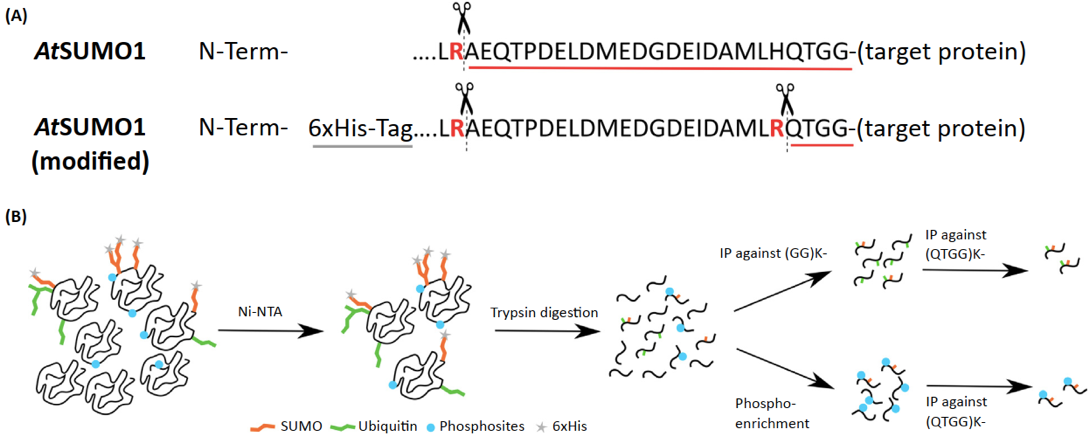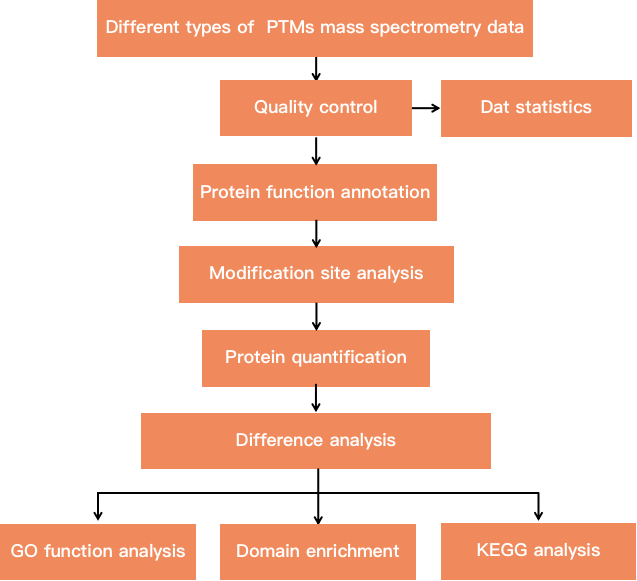Protein Post-Translational Modifications
With years of mass spectrometry technical services and proteomics data analysis services, CD Genomics provides scientists with fast, efficient and accurate one-stop services to identify and analyze protein post-translational modifications.
Introduction
Protein post-translational modifications (PTMs) increase the functional diversity of proteins through the covalent addition of functional groups or proteins, the proteolytic cleavage of regulatory subunits, or the degradation of the entire protein. Any protein in the proteome can be modified during or after translation. Different types of modifications will affect the charge state, hydrophobicity, conformation or stability of the protein, and ultimately affect its function. These modifications include phosphorylation, glycosylation, ubiquitination, nitrosylation, methylation, acetylation, lipidation, and proteolysis. Compared to proteins that have not been modified, PTMs can cause an increase in the molecular weight of specific sequences. In the process of identifying the post-translational modification of the protein, the protein will first be cleaved into peptides, and then enter the mass spectrum for analysis. Through mass spectrometry, what is obtained is the molecular mass information of a series of peptides. For a specific peptide, its sequence information and molecular weight are determined without any post-translational modification. Protein post-translational modifications affect almost all aspects of normal cell biology and pathogenesis. Therefore, the identification and analysis of protein post-translational modification are essential for the identification and understanding of PTM in the research of cell biology and disease treatment and prevention.
 Fig 1. Strategy to Detect Peptides Co-Modified by Different Protein Post-Translational Modifications (PTMs). (Vu L D, et al. 2018)
Fig 1. Strategy to Detect Peptides Co-Modified by Different Protein Post-Translational Modifications (PTMs). (Vu L D, et al. 2018)
Application Filed
In the field of biomedicine, protein post-translational modification analysis is widely used in various directions:
- Basic medicine research: Research on the mechanism of disease occurrence and development, biomarker discovery, disease mechanism research, drug action mechanism, drug efficacy evaluation, drug development.
- Clinical diagnosis: disease classification, personalized treatment and health research.
What We Offer
Biomedical-Bioinformatics, a division of CD Genomics, provides different types of protein post-translational modification analysis according to the needs of researchers, accelerating your identification of protein post-translational modifications in cell biology and disease treatment and prevention research. CD Genomics provides different software or packages to perform post-translational modification analysis and visual analysis for researchers to meet their personalized needs. In addition, you only need to provide us with your original data (including different post-translational modification mass spectrometry data, such as phosphorylation, glycosylation, acetylation, ubiquitination, carboxylation, ribosylation, and disulfide bond paired mass spectrometry data), or other intermediate data files. We will evaluate the data, preprocess it, and identify different types of protein post-translational modifications, and finally generate a complete report, in which high-quality and easy-to-interpret images and tables can be used for publication of the article.
Data Analysis Technical Route
 Fig 2. Protein post-translational modification analysis flow chart
Fig 2. Protein post-translational modification analysis flow chart
Data Ready
Before data analysis, the first thing is to get your data ready. For protein post-translational modification analysis, the raw input data can be experimental raw data generated in your own laboratory or that of a 3rd party provider or downloaded from public databases.

For protein post-translational modification analysis services, if you have any questions about the data analysis cycle, analysis content and price, please click online inquiry.
What's More
For protein post-translational modification analysis, if you have yet to generate the raw data, CD Genomics relies on years of experience in mass spectrometry technology services to provide you with different types of post-translational modification identification services. In addition, we also provide services to obtain raw data from public databases. In short, we are happy to work with you at every stage of your research to ensure the best outcome for your study. If you have any questions about our protein post-translational modification analysis service, please feel free to contact us for details.
References
- Vu L D, et al. Protein Language: Post-Translational Modifications Talking to Each Other[J]. Trends in Plant science. 2018 Dec;23(12):1068-1080.
- Marcelli S, et al. The Involvement of Post-Translational Modifications in Alzheimer's Disease[J]. Curr Alzheimer Res. 2018 Feb 22;15(4):313-335.
* For research use only. Not for use in clinical diagnosis or treatment of humans or animals.
Online Inquiry
Please submit a detailed description of your project. Our industry-leading scientists will review the information provided as soon as possible. You can also send emails directly to for inquiries.
